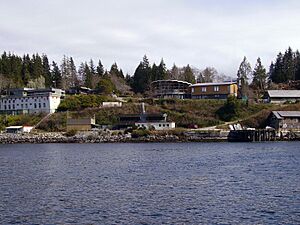Bamfield Marine Sciences Centre facts for kids
The Bamfield Marine Sciences Centre is a special place where scientists study the ocean. It used to be called the Bamfield Marine Station. This research station started in 1972.
It is located in a beautiful area called Bamfield, in Barkley Sound, British Columbia. Several universities work together to run the centre. These include the University of Victoria, the University of British Columbia, Simon Fraser University, the University of Alberta, and the University of Calgary.
The centre offers many fun and educational programs. These programs teach people about marine science. They have special trips for school children. University students can also take courses there. These courses run during the summer and fall.
History of the Centre
The Bamfield Marine Sciences Centre is in a very old building. This building was once part of a huge worldwide undersea cable system. It was called the All Red Line. This system helped send messages across the British Empire.
The building was originally the Pacific Cable Board (PCB) Cable Station. It was the starting point for a telegraph cable. This cable linked Canada to Fanning Island. Fanning Island is about 1,600 kilometres south of Hawaii. The telegraph cable worked from 1901 until 1959.
From 1969 to 1980, the centre helped collect important ocean data. It was part of the British Columbia Shore Station Oceanographic Program. They measured ocean temperature and saltiness every day. This information was for the Department of Fisheries and Oceans.
What the Centre Does Today
The centre helps with modern ocean research too. It supports projects in Folger Passage and Barkley Sound. This work is done with a group called Ocean Networks Canada. They use special equipment to study the ocean floor.
In April 2016, the centre worked with the Huu-ay-aht First Nations. They also partnered with the Hakai Institute. Together, they launched a drone. The drone took many pictures. These pictures helped them map parts of the Barkley Sound area.
Leadership
Dr. Sean Rogers became the director of the centre on July 1, 2018. He is a biology instructor from the University of Calgary. Dr. Rogers had taught university courses at the centre before. He was also the acting director in 2016.




